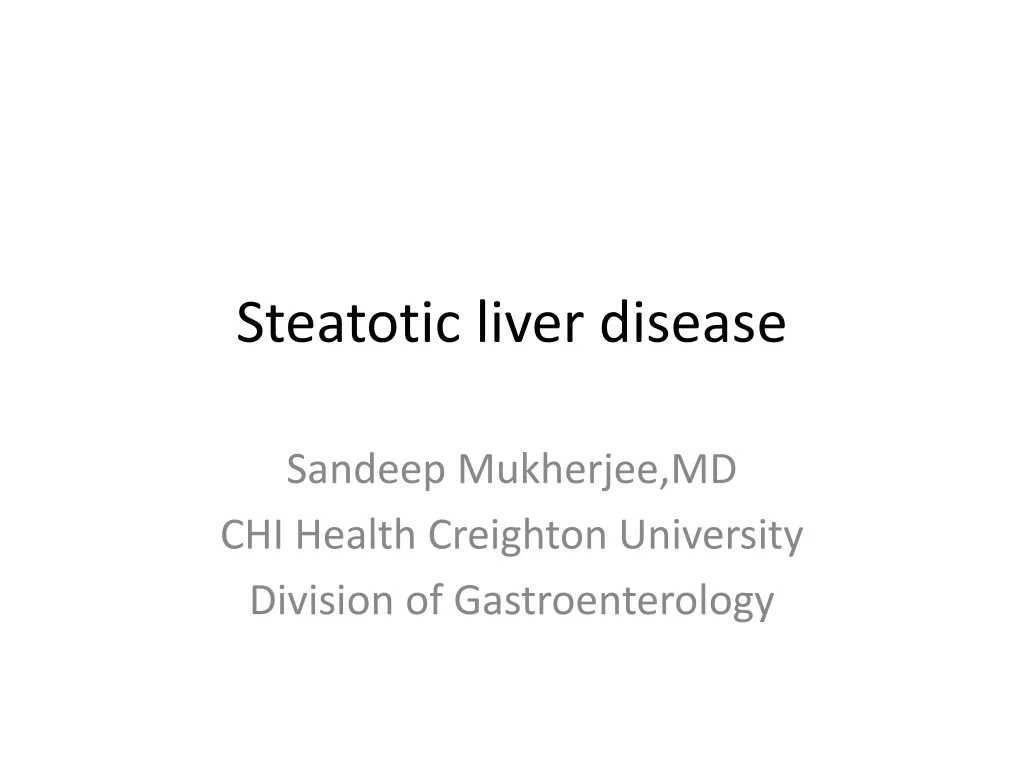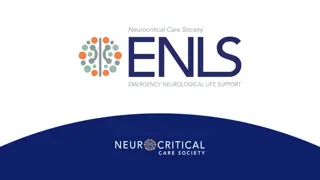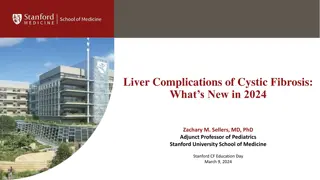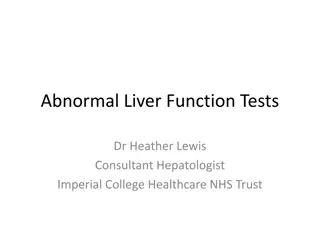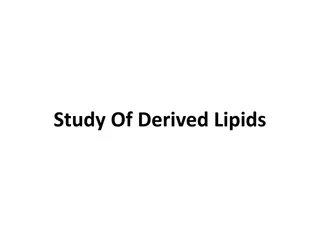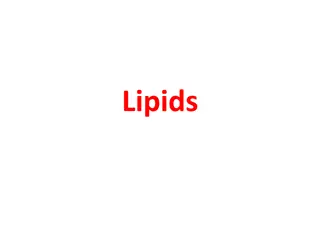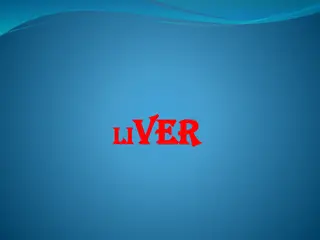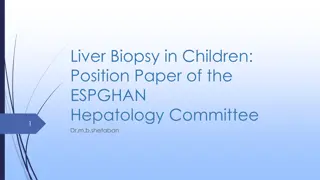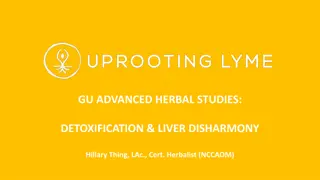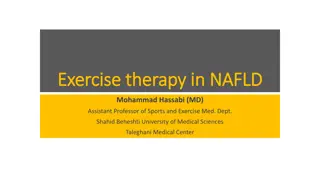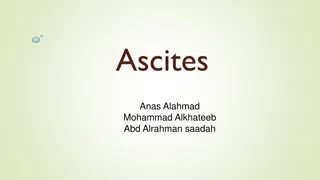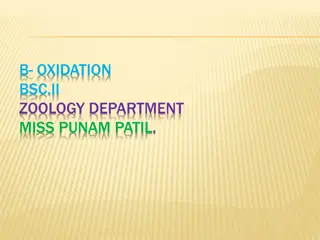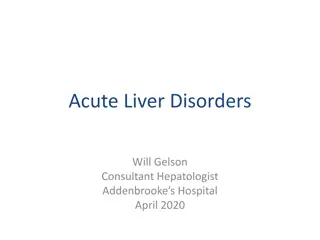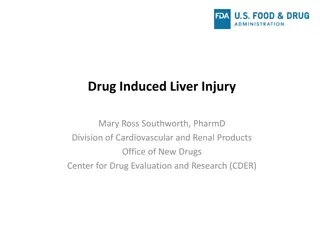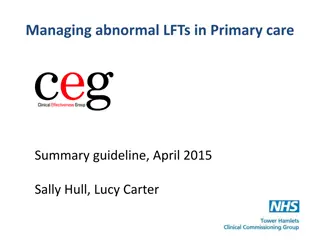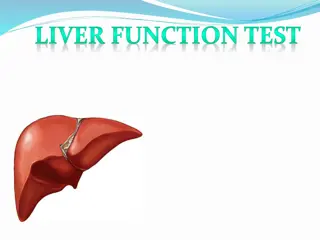Pharmacotherapy for Non-Alcoholic Fatty Liver Disease: An Updated Review by Anita Eftekharzadeh
This comprehensive review discusses the pharmacotherapy options for Non-Alcoholic Fatty Liver Disease (NAFLD), covering topics such as sub-classification of NAFLD, proposed risk stratification, non-invasive measures for assessing liver fibrosis, and the NAFLD Activity Score (NAS). Anita Eftekharzadeh, MD, presents insights on treatment strategies, monitoring, and recommendations for patients with Type 2 Diabetes Mellitus (T2DM) and NAFLD. The review also delves into the rationale behind addressing NASH for improved patient outcomes and liver health.
Download Presentation

Please find below an Image/Link to download the presentation.
The content on the website is provided AS IS for your information and personal use only. It may not be sold, licensed, or shared on other websites without obtaining consent from the author.If you encounter any issues during the download, it is possible that the publisher has removed the file from their server.
You are allowed to download the files provided on this website for personal or commercial use, subject to the condition that they are used lawfully. All files are the property of their respective owners.
The content on the website is provided AS IS for your information and personal use only. It may not be sold, licensed, or shared on other websites without obtaining consent from the author.
E N D
Presentation Transcript
Pharmacotherapy for Non-Alcoholic Fatty Liver Disease An Updated Review Anita Eftekharzadeh, MD Endocrinologist Research Institute for Endocrine Sciences July 2016, Tehran
OUTLINE Rationale and Definitions Treatment of patients with T2DM and NAFLD Review of Literature Insulin sensitizers Anti-lipidemic Antioxidants Anti-inflammatory Probiotics Cytoprotective/ anti-apoptotic agents Upcoming drugs Herbal Pediatric NAFLD Monitoring of treatment Recommendations Take home messages A. EFTEKHARZADEH 3
Sub-classification of NAFLD NAFL Pure steatosis Steatosis and mild lobular inflammation NASH Early NASH: no or mild (F0-F1) fibrosis Fibrotic NASH: significant ( F2) or advanced ( F3, bridging) fibrosis NASH-cirrhosis (F4) Hepatocellular carcinoma Diabetologia 2016; 59 1121-1140 A. EFTEKHARZADEH 4
Proposed risk stratification for patients with NAFLD Nat Rev Gastroenterol Hepatol. 2016 Apr;13(4):196-205 A. EFTEKHARZADEH 5
NON-INVASIVE MEASURES NAFLD fibrosis score (NFS): Estimates fibrosis using age, BMI, AST, ALT, Plt, Albumin and history of IFG/DM Hepatology 2007;45(4):846-854 Fibrosis-4 (FIB-4) Index: Noninvasive estimate of liver scarring in HCV and HBV patients, using age, AST, ALT and Plt. J Viral Hepat. 2013;20(1):72-76 APRI: The aspartate aminotransferase-to-platelet ratio index (APRI), a tool for detecting hepatic fibrosis Hepatology. 2011;53(3):726-36 A. EFTEKHARZADEH 6
NAFLD ACTIVITY SCORE (NAS) NAS is the sum of the separate scores for steatosis (0 3), hepatocellular ballooning (0 2) and lobular inflammation (0 3) The majority of patients with NASH have a NAS score of 5. This system was developed as a tool to quantify changes in NAFLD during therapeutic trials. The cutoff NAS score 5 cannot be used as a surrogate of histological diagnosis of NASH that is usually performed by expert-based evaluation of pathologic patterns for NASH. Hepatology 2005;41 1313 1321 A. EFTEKHARZADEH 7
RATIONALE Successful treatment of NASH should improve outcome, i.e. decrease NASH- related mortality, reduce progression to cirrhosis or HCC. Given the low probability of adverse liver-related outcomes in those in the low-risk categories of NAFLD, most patients do not warrant pharmacological treatment Resolution of the histological lesions of NASH is accepted as a surrogate endpoint. Diabetologia 2016; 59 1121-1140 Nat Rev Gastroenterol Hepatol. 2016;13 196-205 A. EFTEKHARZADEH 8
INSULIN SENSITIZERS Thiazolidinediones The PIVENS trial (the Pioglitazone, Vitamin E or placebo for NASH) Fibrosis scores were not improved with either active treatment Metfomin RCT with 110 non-diabetic NAFLD; better than Vitamin E in improving ALT Not confirmed by other trials Incretin mimetics Phase II trial with Liraglutide vs. placebo; 52 overweight Pt. with NASH Possible role in delaying progression of fibrosis Gastroenterology Research and Practice, 2016; 7109270 A. EFTEKHARZADEH 9
THE PIVENS TRIAL Randomized, double blinded, multi center, placebo controlled 247 non-diabetic patients with Bx proven NASH; 96 wks Three groups: pioglitazone 30 mg daily; vitamin E 800 IU daily; placebo Primary endpoint: in NAS by at least 2 points, & improvement in ballooning by 1 point New England Journal of Medicine 2010; 362:1675-1685 A. EFTEKHARZADEH 10
THE PIVENS 90% underwent end-of-treatment Bx at 96 wks Vit E vs placebo: Higher rate of improvement in NASH (43% vs. 19%) Sig. better if no worsening of ballooning set as criterion (51% vs 25%) Pioglitazone vs placebo: No improvement in primary outcome (34% vs. 19%, p=0.04) Sig. better if no worsening of ballooning set as criterion (48% vs 25%, p=0.003) Fibrosis scores were not significantly improved with either active treatment New England Journal of Medicine 2010; 362:1675-1685 A. EFTEKHARZADEH 11
INSULIN SENSITIZERS Pioglitazone Metfomin RCT with 110 non-diabetic NAFLD; better than Vitamin E in improving ALT (Bugianesi et al, 2005); Not confirmed by other trials Most studies: No additional histological/ biochemical benefit Incretin mimetics Phase II trial with Liraglutide vs. placebo; 52 overweight Pt. with NASH Possible role in delaying progression of fibrosis Gastroenterology Research and Practice, 2016; 7109270 A. EFTEKHARZADEH 12
The LEAN Trial Multicenter, double-blinded, RCT phase II; 48 wks 52 overweight (diabetic and non-diabetic) pts; Liraglutide 1.8 mg/d vs placebo Primary outcome: disappearance of ballooning without worsening of fibrosis Secondary outcome: changes in NAS, liver enzymes, non-invasive biomarkers, Lancet 2016; 387: 679 90 A. EFTEKHARZADEH 13
THE LEAN TRIAL 39% in the Tx group vs 9% in the Pl group had resolution of definite NASH with no worsening of fibrosis, thereby meeting the primary outcome The RR of response when receiving Lira vs Pl, adjusted for diabetes was 3 7 (1 0 13 5; p=0 047) Fewer patients in the Lira group had progression of fibrosis than in the Pl group (9% vs 26%) No differences were seen in lobular inflammation and overall NAFLD activity score Lancet 2016; 387: 679 90 A. EFTEKHARZADEH 14
ANTILIPIDEMICS Fibrate Improvement(?) in liver enzymes, but no histologic changes Niacin Possible hepatotoxic effects in some studies NPC1L1 inhibitor RCT with 32 bx proven NAFLD; Ezetimibe 10 vs. placebo for 6 months; sig. improvement in ballooning/ fibrosis but no change in inflammation/ steatosis; significant increase in hepatic long-chain FA, oxidative stress, IR and HbA1C Gastroenterology Research and Practice, 2016; 7109270 A. EFTEKHARZADEH 15
POLYUNSATURATED FATTY ACIDS (PUFA) RCT with 37 pts; Bx proven NASH; PUFA vs. placebo; 48 wks; sig. improvement in steatosis & NAS in placebo group, worsening of IR in PUFA group. RCT with 34 pts; Bx proven NASH; n-3 fish oil 3000 mg/d for 1 y; No difference between the 2 group Gastroenterology Research and Practice, 2016; 7109270 A. EFTEKHARZADEH 16
STATINS Beneficial effect on NAFLD likely due to anti-inflammatory, antioxidants and antifibrogenic properties RCT involving hyperlipidemic pts with US evidence of NAFLD; comparing Atorvastatin 20 daily, Fenofibrate 200 daily and combination Atorvastatin alone and combination had a higher degree of biochemical and US NAFLD regression Gastroenterology Research and Practice, 2016; 7109270 A. EFTEKHARZADEH 17
ANTIOXIDANTS Vitamin E The PIVENS trial/ The TONIC trial: No improvement in fibrosis Vit E 1000 IU/d + Vit C 1000 mg/d for 6 M (45 pts with Bx proven NASH): improvement in fibrosis but not in necroinflammaton and ALT Vit E + pioglitazone vs Vit E alone (small study): improvement in fobrosis Vit E + ursodeoxycholic acid (UDCA) for 2 y (48 pts with Bx proven NASH): improvement in ALT and steatosis S-adenosyl methionine (SAM), N-acetyl cysteine (NAC) Short duration, small samples, not enough evidence to support or oppose its use Gastroenterology Research and Practice, 2016; 7109270 A. EFTEKHARZADEH 18
ANTI-INFLAMMATORY Pentoxifylline A xanthine derivative, inhibits TNF alpha RCT with 49 pts (Bx proven NASH); placebo controlled trial; Significant improvement in ALT, steatosis, inflammation, fibrosis; No change in ballooning RCT with 30 pts; no improvement in ALT & histology Meta-analysis of RCTs: Pentoxifylline significantly reduced ALT, BMI, FPG, steatosis, lobular inflammation and fibrosis Larger well designed RCTs still needed to confirm these results Gastroenterology Research and Practice, 2016; 7109270 A. EFTEKHARZADEH 19
PROBIOTICS Intestinal bacterial content may be related to the pathogenesis of NASH Probiotics tested: Lactobacillus bulgaricus, Streptococcus thermophilus, Bifidobacterium longum Meta-analysis of 4 double-blind RCT with 134 Bx proven NAFL/NASH patients: probiotics significantly decrease T.Chol, aminotransferases, HOMA-IR and TNF alpha. Gastroenterology Research and Practice, 2016; 7109270 A. EFTEKHARZADEH 20
CYTOPROTECTIVE/ ANTIAPOPTOTIC AGENTS Ursodeoxycholic acid (UDCA) Mixed results with low and high dose UDCA Systematic review: UDCA monotherapy improved liver enzymes, steatosis and fibrosis in few studies UDCA combined with other drugs showed greater improvement in steatosis and inflammation There might be variation in outcome with low and high dose UDCA Gastroenterology Research and Practice, 2016; 7109270 A. EFTEKHARZADEH 21
OTHER THERAPEUTIC AGENTS Renin-Angiotensin-Aldosterone System (RAAS) inhibitors: Cross-sectional study; 290 pts with NAFLD; with and without RAAS blocker; less ballooning and lower fibrosis stage in pts on RAAS blockers. 54 pts with HTN and NASH; randomized to Valsartan/Telmisartan for 20 M; Both improved OT/PT and IR; Telmisartan improved NAS & fibrosis Gastroenterology Research and Practice, 2016; 7109270 A. EFTEKHARZADEH 22
HERBAL Milk thistle (silymarin) Antioxidant, anti-inflammatory, antifibrogenic activity; help with liver cell regeneration RCT; Silybin in combination with vitamin E and phospholipids; improved steatosis RCT; In combination with phophatidylcholine; 138 pts for 12 M; significant improvement in liver enzymes, HOMA-IR, liver histology Gastroenterology Research and Practice, 2016; 7109270 A. EFTEKHARZADEH 23
UPCOMING DRUGS A. EFTEKHARZADEH 24
Therapeutic agent Target Proposed mode of action BMS986036 Modulation of FGF21 metabolism Improvement of hepatic lipid and glucose metabolism; anti-inflammatory Cenicriviroc CCR2 and CCR5 Inhibition of CCR2- and CCR5-mediated monocyte/macrophage infiltration and inflammation Elafibranor Modulation of hepatic PPAR and PPAR pathways Stimulation of NEFA oxidation; improvement of lipid and glucose metabolism; prevention of inflammation Emricasan Caspase pathways (pan- caspase inhibitor) Inhibition of fibrosis by blocking caspase protease activation and apoptosis pathways GR-MD-02 Galectin-3 inhibitor Prevention of inflammation and fibrosis Obeticholic acid FXR agonist Regulation of hepatic glucose and lipid metabolism Px-104 FXR agonist Regulation of hepatic glucose and lipid metabolism Simtuzumab LOXL2 enzyme activity Inhibition of fibrosis by a LOXL2 monoclonal antibody Diabetologia 2016;59 1112-1120 FXR, Farnesoid X receptor; LOXL2, Lysyl oxidase-like 2 A. EFTEKHARZADEH 25
THE FLINT STUDY Multicenter, double-blind RCT 283 pts assigned to either 25 mg Obeticholic acid or placebo The primary outcome measure was a decrease in NAS by at least 2 points without worsening of fibrosis from baseline to the end of treatment (72 wks). Stopped early because of efficacy. Obeticholic acid improved hepatic steatosis, inflammation, hepatocyte ballooning, and fibrosis. Lancet 2015;385 956-965 A. EFTEKHARZADEH 26
Rationale and Definitions Treatment of patients with T2DM and NAFLD Review of Literature Insulin sensitizers Anti-lipidemic Antioxidants Anti-inflammatory Probiotics Cytoprotective/ anti-apoptotic agents Upcoming drugs Herbal Pediatric NAFLD Monitoring of treatment Recommendations Take home messages A. EFTEKHARZADEH 27
TYPE 2 DM AND NAFLD More aggressive form of hepatocyte injury Higher risk of fibrosis, end-stage liver disease and HCC Strong association with cardiovascular disease May worsen microvascular disease in diabetes Diabetologia 2016;59 1112-1120 A. EFTEKHARZADEH 28
TYPE 2 DM AND NAFLD Metformin: Negative results in children and adults Pioglitazone: Enhances insulin sensitivity and prevents excessive lipolysis; Unpublished positive results in IFG/IGT with NAFLD GLP-1 receptor agonists (Liraglutide) Improve Bx proven NASH as suggested by the LEAN trial Diabetologia 2016;59 1112-1120 A. EFTEKHARZADEH 29
TYPE 2 DM AND NAFLD Depeptidyl peptidase 4 (DPP-4) inhibitors Sitagliptin: neutral/ decrease ALT; impact on histology unknown Vildagliptin: small reduction in hepatic triacylglycerol accumulation Sodium-glucose cotransporter 2 (SGLT 2) inhibitors (antifibrotic in animals) Canagliflozin 300 mg vs Sitagliptin (52 wks): significant reduction in ALT; might be due to in Hb A1C and body weight. The role of reversing glucotoxicity per se on NASH (independent of treating insulin resistance) has never been examined in an RCT in type 2 DM A. EFTEKHARZADEH 30
PEDIATRIC NAFLD Diet and exercise training reduce steatosis, but do not affect ballooning, inflammation and fibrosis. Vit E, metformin, probiotics and docosahexanoic acid have shown beneficial effects on ballooning, steatosis and inflammation. Fibrotic lesions are refractory to treatment. Long-term outcome of pediatric NASH is poor. Diabetologia 2016; 59 1121-1140 A. EFTEKHARZADEH 31
TREATMENT OF NAFLD IN CHILDREN (TONIC) Vitamin E, metformin vs. placebo Multicenter, double-blind RCT 137 pts, aged 8-17 y, 800 IU Vit E or 1000 mg Metformin or placebo Hepatology 2012;55 1292-1300 A. EFTEKHARZADEH 32
PEDIATRIC NAFLD The primary outcome: sustained reduction in ALT (50% or less of the baseline level or 40 U/L or less at visits every 12 weeks from 48 to 96 weeks of treatment) Improvements in histological features of NAFLD and resolution of NASH were secondary outcome measures. Vitamin E improved liver enzyme levels and histology but, Treatment group did not met the primary end point of a sustained reduction (> 6 month) No improvement in fibrosis Neither vitamin E nor Metformin was superior to placebo in attaining the primary outcome of sustained reduction in ALT level Hepatology 2012;55 1292-1300 A. EFTEKHARZADEH 33
MONITORING OF TREATMENT Monitoring should include routine biochemistry, assessment of comorbidities and non-invasive monitoring of fibrosis. NAFL patients without worsening of metabolic risk factors, should be monitored at 2 3-year intervals. Patients with NASH and/or fibrosis should be monitored annually, those with NASH cirrhosis at 6-month intervals. If indicated on a case-by-case basis, liver biopsy could be repeated after 5 years Journal of Hepatology 2016vol. 64j 1388 1402 A. EFTEKHARZADEH 34
MONITORING OF TREATMENT Noninvasive methods to document treatment efficacy are lacking. Liver biopsy is necessary to determine treatment efficacy. Normalization of ALT level combined with even modest weight loss increases the probability of histological improvement in NASH to ~90% in those receiving vitamin E. (PIVENS trial) A decreased in the FIB-4 and APRI indices after 6 months of treatment were shown to be predictive of improved fibrosis after 72 weeks of treatment in those receiving obeticholic acid. (FLINT study) Nat Rev Gastroenterol Hepatol. 2016 Apr;13(4):196-205 A. EFTEKHARZADEH 35
RECOMMENDATIONS A. EFTEKHARZADEH 36
RECOMMENDATIONS 2016 European Association for the Study of the Liver (EASL) European Association for the Study of Diabetes (EASD) European Association for the Study of Obesity (EASO) 2014 World Gastroenterology Organization (WGO) A. EFTEKHARZADEH 37
REGULATION No drug has currently been tested in phase III trials and is approved for NASH by regulatory agencies. No specific therapy can be firmly recommended. Safety and tolerability are essential prerequisites. Diabetologia 2016; 59 1121-1140 A. EFTEKHARZADEH 38
Grading Grading of evidence Notes Symbol Further research is very unlikely to change our confidence in the estimate effect Further research is likely to have an important impact on our confidence in the estimate of effect and may change the estimate effect A High quality B Moderate quality Further research is very likely to have an important impact on our confidence in the estimate of effect and may change the estimate effect. Any estimate of effect is uncertain Low or very low quality C Grading of recommendations Factors influencing the strength of the recommendation included the quality of the evidence, presumed patient- important outcomes, and cost Strong recommendation 1 Variability in preferences and values, or more uncertainty: more likely a weak recommendation is warranted Recommendation is made with less certainty; higher cost or resource consumption Weaker recommendation 2 A. EFTEKHARZADEH 39
RECOMMENDATIONS Pharmacotherapy should be reserved for patients with NASH (esp. for those with stage F2 and higher) (B1) Patients at high risk of disease progression (with DM, MetS, persistently increased ALT, high necro-inflammation) could also be candidates to prevent disease progression. (B1) Diabetologia 2016; 59 1121-1140 Journal of Clinical Gastroentrology 2014; 48 467-473 A. EFTEKHARZADEH 40
RECOMMENDATIONS Pioglitazone (most efficacy data, off-label outside T2DM) or Vitamin E (better safety and tolerability in the short-term) or their combination could be used for NASH (B2) The optimal duration of therapy is unknown (C2) In patients with increased ALT at baseline, treatment should be stopped if there is no reduction in aminotransferases after 6 months of therapy (C2) In patients with normal ALT at baseline, no recommendations can be made (C2) Diabetologia 2016; 59 1121-1140 A. EFTEKHARZADEH 41
TAKE HOME MESSAGES Not every patient with fatty liver needs pharmacotherapy Pharmacotherapy should be started on a stage-based (biopsy proven?) approach Pay special attention to high risk patients (with DM, MetS, HTN, persistently increased ALT) Vitamin E and pioglitazone are the most effective drugs in treating NASH Vitamin E may have better efficacy when combined with other agents Long term side effects of each medication should be kept in mind A. EFTEKHARZADEH 42
REFERENCES 1. European Association for the Study of the Liver (EASL), European Association for the Study of Diabetes (EASD) & European Association for the Study of Obesity (EASO). EASL-EASD-EASO Clinical Practice Guidelines for the Management of Non-Alcoholic Fatty Liver Disease. Diabetologia (2016) 59: 1121. 2. Newaz Hossain, Pushpjeet Kanwar, and Smruti R. Mohanty. A Comprehensive Updated Review of Pharmaceutical and Nonpharmaceutical Treatment for NAFLD. Gastroenterology Research and Practice (2016). 3. Kenneth Cusi. Treatment of patients with type 2 diabetes and non-alcoholic fatty liver disease: current approaches and future directions. Diabetologia (2016) 59: 1112. 4. World Gastroenterology Organisation Global Guidelines: Nonalcoholic Fatty Liver Disease and Nonalcoholic Steatohepatitis. Journal of Clinical Gastroenterology (2014) 48: 467 473 5. Alkhouri, Naim, and Ariel E. Feldstein. The TONIC Trial: A Step Forward in Treating Pediatric Nonalcoholic Fatty Liver Disease. Hepatology (Baltimore, Md.) 55.4 (2012): 1292 1295. A. EFTEKHARZADEH 43
Thank you for your attention A. EFTEKHARZADEH 44


